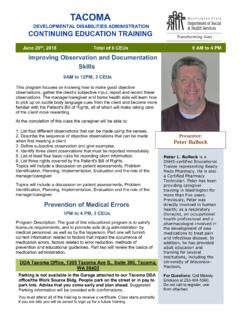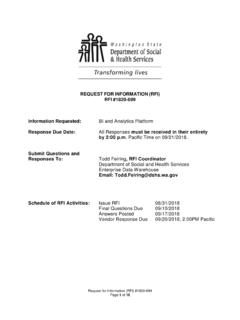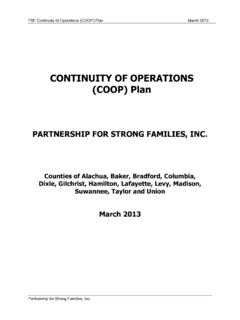Transcription of Continuity of Operations Plan - Transforming Lives
1 - 1 - CFSP 2010 - 2014 Appendix: (1B) Continuity of Operations plan June 30, 2009 CCoonnttiinnuuiittyy ooff OOppeerraattiioonnss PPllaann State of Washington Department of Social and Health Services Children's Administration May 2009 DSHS Children s Administration Emergency Management plan - 2 - CFSP 2010 - 2014 Appendix: (1B) Continuity of Operations plan June 30, 2009 Table of Contents Introduction .. 3 Emergency Event Response .. 3 Incident Command System .. 4 Major or catastrophic Disaster Response Process .. 7 Command Priority Activities .. 8 Lines of Succession .. 17 DISASTER RESPONSE APPENDICES 1. CA Headquarters Emergency Planning and Response Team 2. Key Emergency Contact Numbers, DSHS Employee Information Line Responsibilities, Office Building 2 Emergency Evacuation Map 3.
2 Emergency Notification and Command Levels 4. Templates Initial Report of Emergency, Incident Action plan , Damage Assessment, Volunteer Assignments 5. Technology Services Division Emergency plan 6. Finance and Operations Support Division Emergency plan 7. Program and Practice Improvement Division Emergency plan 8. Field Operations Division Emergency plan DSHS Children s Administration Emergency Management plan - 3 - CFSP 2010 - 2014 Appendix: (1B) Continuity of Operations plan June 30, 2009 Introduction The Department of Social and Health Services (DSHS) Children s Administration (CA) has the overall authority and responsibility to protect employees, clients, automated data systems, and business Operations during an event that causes interruption of normal day-to-day business or which may cause harm.
3 The CA Emergency Management plan and the DSHS Comprehensive Emergency Management plan provide the foundational framework and roadmap to analyze and mitigate potential probable threats and risks associated with an emergency event. The Continuity of Operations plan identifies business Operations , service delivery, and key employees and their roles during and after an emergency or disaster event (see also Appendix 1(B) Attachments 3, 5, 6, 7, and 8). Threat or disaster events occur in many forms, , fire, flood, bomb threat, threat of physical injury, technological threats, weapons, pandemic disease, bio-terrorism, civil disturbance, natural disasters, gas or hazardous chemical leaks, utility failures, or any other event that places the environment at risk of being unsafe or uninhabitable for clients, visitors, and employees.
4 Such events may require DSHS participation in a standard incident response system. Key emergency numbers and areas of responsibility are attached (see Appendix 1(B) Attachment 2). Emergency Event Response Response to an emergency event depends on its classification level. The local site or program makes the first determination regarding the emergency and command levels and immediate notification requirements. The Emergency Notification and Command Levels (see Appendix 1(B) Attachment 3), the Initial Report of Emergency and other tools (see Appendix 1(B) Attachment 4) are attached. The Secretary and Assistant Secretary determine the individuals needed to respond to the event. Triage and Notification MinorProblemMajorEventorPhone CallEmailFAX, otherManagementorCall CenterReceivesNotificationof MinorproblemReceivesNotificationOf MajorEventTriage InitialReportofEmergencyTriage InitialReportofEmergencyLevel IMinorAction TakenToResolveIncidentNo FurtherAction RequiredLevel IIMajorAppropriateDSHS ICS SectionsActivated(Yes)SituationResolved( No)Consider Escalating to DSHS ESTN otifyEMDS haredICS CommandActivateAppropriate DSHS ICSS ectionsLevel IIIC atastrophicActivateDSHS EOCDSHS Children s Administration Emergency Management plan - 4 - CFSP 2010 - 2014 Appendix.
5 (1B) Continuity of Operations plan June 30, 2009 Incident Command System An essential piece in emergency planning is determining who is in charge during an event and what they need to do. Minor events may not require establishing a command structure. Large scale events may require multiple command teams responding to a single incident. If a major or catastrophic event occurs, the department may activate an Incident Command System (ICS). This includes certain Level 2 events all events that affect DSHS co-located facilities and all Level 3 events. The National Incident Management System (NIMS) requires that response to all domestic incidents use a common management structure that enables all government, private-sector, and non-governmental organizations to work together during domestic incidents.
6 The Incident Command Team consists of a leader, the Incident Commander, and other staff who are responsible for the various parts of the plan . The Incident Commander has overall responsibility for managing the event by objectives, planning strategies, and implementation tactics. The number of Incident Command System staff needed to respond to an emergency depends on the size and seriousness of the event. DSHS Headquarters Command Emergency Support Team (EST): The Headquarters Command EST functions only during certain major or catastrophic events. Its role generally is to support regional and local command teams; however, it could be designated as primary command in a large scale event. In a catastrophic event, this EST will likely be coordinating with other state agencies and the federal government.
7 DSHS Emergency Support Team Incident Commander EOCC ommanderAssistant and Deputy Secretaries Regional CommandTeams (RCT)EmergencyResponseTeams (EPRT)AssistantAGPublic Info Officer (PIO) MedicalConsultantLiaisonEMD EOCS afety/SpecialInterest DSHSF inanceSectionStaff ResourcesSectionInfrastructureSupport SectionPlanningSectionLogisticsSection Health/Welfare Staff AssistanceStaff AssignmentAnd Deployment Facilities Building SecurityCommunicationSystemInformationTe chnology Situation UnitEmergencyOperationsCenter (EOC)Support StaffPurchasingContractingEmergencyHousi ng Food Travel Signs & Badges TransportationRecordsManagementEventFina ncialManageFinancial Operation Budget Cost Tracking Claims Cast Mgmt Cost RecoveryContractNegotiations/ManagementM utual AidContractsClient or VictimFinancial Support EBT Food Stamps Waiver Requests Data Entry Client Protection ADSA CA JRA MH DASA Crisis Counseling MH DASACase Management ADSA CA Residential Care ADSA JRA MH SCCL iaisonEMD Policy Room The DSHS command structure ensures an orderly response to an event, which leads to the recovery of business Operations and service delivery.
8 Emergency response should occur at the lowest organizational level possible. Command teams within DSHS: Local Command Team responds and manages an incident at the site where the incident occurred (facility or office). DSHS Children s Administration Emergency Management plan - 5 - CFSP 2010 - 2014 Appendix: (1B) Continuity of Operations plan June 30, 2009 Program or Support Services Incident Command Teams manage the Continuity of service delivery. They generally do not originate from the site where the incident occurred. They may operate remotely from the affected site or they may travel to the affected site. DSHS Regional Emergency Support Teams (EST) will be established in all regions (1-6) and consists of staff representing each of the DSHS Administrations that have employees or services in the field.
9 Generally, these teams function only during certain major or catastrophic events to support local command teams and provide command coordination. Children s Administration may establish an Incident Command Team at the headquarters level. The Assistant Secretary or designee will assume the role of Incident Commander and coordinate with and take direction from the DSHS Secretary through the Executive Team or the DSHS Emergency Support Team, if activated. The Incident Command Team has responsibility for communicating with the secondary level of response teams. In the event of a major or catastrophic disaster, the Children s Administration headquarters may activate its Emergency Planning and Response Team (EPRT) (see Appendix 1(B) Attachment 1) to assist the affected area(s) and support the continuance of vital services.
10 Children s Administration Incident Command System (ICS) Emergency Planning and Response Teams (EPRTs) provide planning and leadership, and respond to emergency situations or disaster events for DSHS programs, facilities, and worksites. These teams report to the Division Director, unless directed otherwise. Their purpose is to minimize the impacts of emergencies and disasters on the people, property, environment, and economy of Washington State. They function to: Protect the safety of staff, clients, and visitors and protect state physical assets. Assure business Continuity . Establish emergency communication with DSHS Headquarters and Regional Command centers. Support local jurisdiction responders and state-wide emergency responders in the case of a disaster.



















